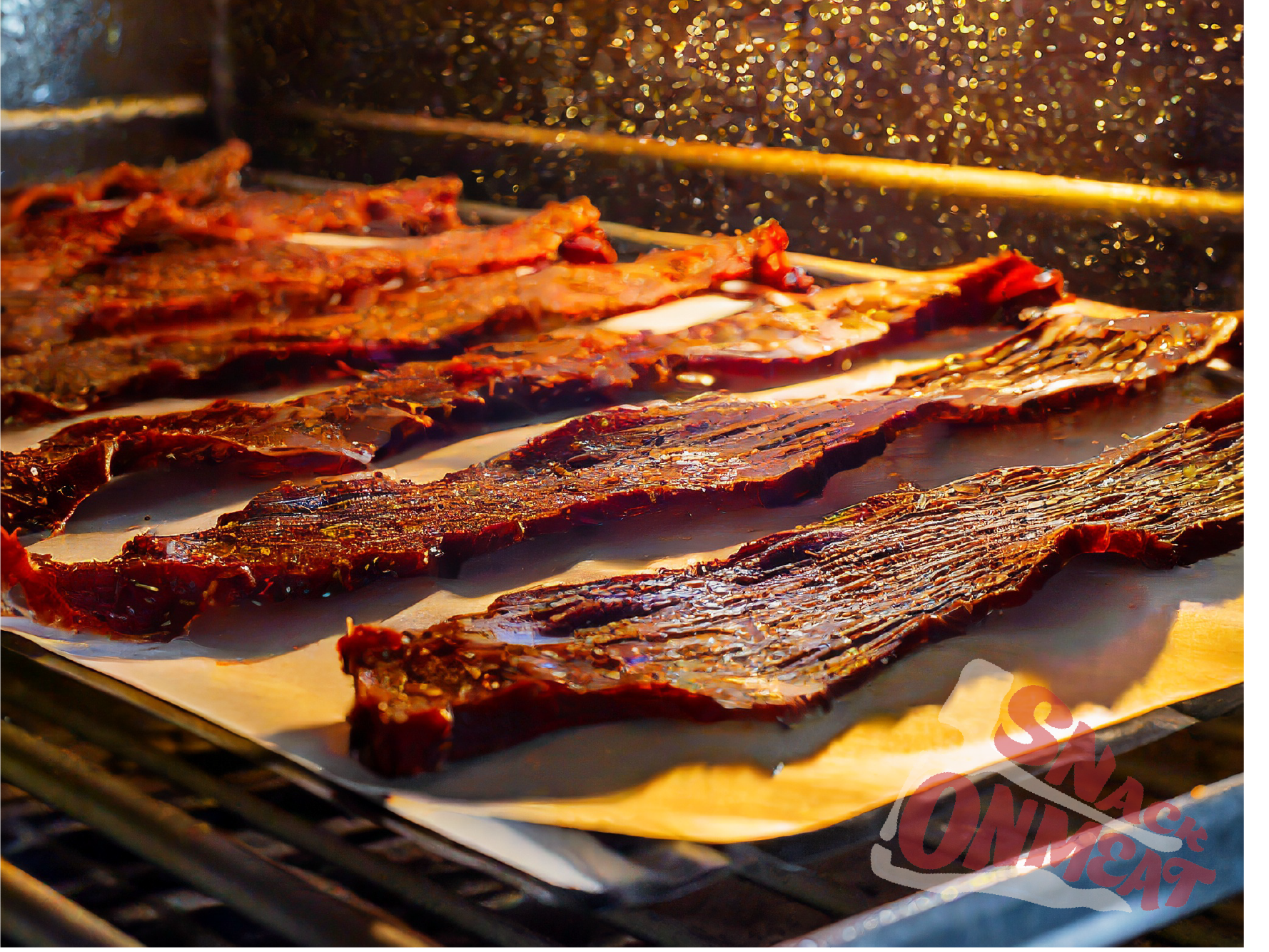There’s something inherently satisfying about sinking your teeth into a piece of beef jerky. For those who appreciate the art of DIY jerky, making your own is a rewarding endeavour. To embark on this flavourful journey, you’ll need the right tools at your disposal. In this guide, we’ll delve into the essential appliances for crafting mouthwatering beef jerky, exploring the equipment you need, the debate, and even how to make beef jerky without relying on technology.
What Equipment Do You Need to Make Beef Jerky?
Before you dive into the world of beef jerky craftsmanship, it’s crucial to gather the necessary equipment. While the list may vary depending on personal preferences and techniques, here’s a comprehensive overview of the must-have appliances:
- Sharp Knife: A sharp knife ensures clean and uniform slices of meat. Consistent thickness is key for even drying.
- Mixing Bowls: Bowls are essential for preparing and mixing your marinade. Choose non-reactive bowls to avoid any metallic aftertaste.
- Refrigerator: Allow the meat to marinate for at least a few hours or overnight. A refrigerator is necessary for keeping the meat chilled during this process.
- Dehydrator or Oven: At the heart of the jerky-making process, a dehydrator or oven is used to slowly dry the marinated meat, preserving its flavour and texture.
- Baking Sheets or Racks: If using an oven, baking sheets or racks are essential to elevate the meat, allowing for proper air circulation.
- Aluminum Foil or Parchment Paper: For easy cleanup and prevention of sticking, line your dehydrator trays or baking sheets with aluminium foil or parchment paper.
- Jerky Gun (Optional): While not essential, a jerky gun simplifies the process of forming uniform strips of jerky when using minced meat. It’s beneficial if you prefer a more traditional jerky appearance.
- Air-tight containers: Storing your jerky correctly is critical for keeping your jerky from spoilage. The best way to store it is in air-tight containers in the fridge.
Now that you have a basic understanding of the equipment needed, let’s delve into the debate surrounding the use of dehydrators for making beef jerky.
Is a Dehydrator the Best Way to Make Jerky?
The dehydrator has become a staple appliance for jerky enthusiasts, thanks to its convenience and precision in the drying process. Here are some reasons why many consider a dehydrator the best way to make jerky:
- Temperature Control: Dehydrators offer precise temperature control, a crucial factor in the jerky-making process. Maintaining a consistent low temperature is essential for slowly drying the meat without cooking it. This results in jerky that is perfectly dehydrated while retaining its natural flavours.
- Efficiency: Dehydrators are designed specifically for drying foods, making them highly efficient for the task at hand. They provide ample space for arranging multiple meat trays, allowing you to easily make larger batches.
- Time Savings: Compared to other methods, dehydrators generally reduce the overall drying time. The controlled environment promotes even drying across all slices, ensuring that each piece of jerky is of consistent quality.
- Energy Efficiency: Dehydrators are designed to operate at low temperatures, making them more energy-efficient than ovens. This not only saves on energy costs but also contributes to a more environmentally friendly jerky-making process.

What Can You Use Instead of a Jerky Gun?
A jerky gun is a convenient tool for extruding strips of seasoned meat, giving your jerky that classic, textured appearance. However, not everyone has access to a jerky gun, and there are viable alternatives for achieving similar results:
- Cookie Cutters: If you’re looking for a simple and creative solution, consider using cookie cutters to shape your jerky. Choose shapes that suit your preferences, whether it’s classic strips or more playful designs.
- Freehand Slicing: For a more rustic look, freehand slicing is an option. Use a sharp knife to cut the marinated meat into strips of your desired width. This method may result in a slightly uneven appearance but doesn’t compromise flavour.
- Roll and Flatten: Another alternative is to roll the marinated meat into a log shape and then flatten it with a rolling pin. This method mimics the texture of traditionally extruded jerky without requiring specialized equipment.
- Strategic Arrangement: If you prefer a more natural look, strategically arrange marinated meat slices on your dehydrator trays or baking sheets. While this won’t give you the same uniform appearance as a jerky gun, it allows for customization and a unique aesthetic.
How to Make Beef Jerky Without Technology?
For those who appreciate the simplicity of traditional methods or find themselves without access to advanced technology, making beef jerky without specialized appliances is entirely feasible. Here’s a step-by-step guide to crafting delicious beef jerky using basic tools:
Ingredients:
- 2 pounds of lean beef (round or flank steak)
- 1 cup soy sauce
- 1/2 cup Worcestershire sauce
- 2 tablespoons liquid smoke
- 1 tablespoon garlic powder
- 1 tablespoon onion powder
- 1 teaspoon black pepper
- Optional: Red pepper flakes for a spicy kick
Instructions:
- Preparation:
- Begin by slicing the lean beef into uniform strips, aiming for a thickness of about 1/4 inch.
- In a mixing bowl, combine soy sauce, Worcestershire sauce, liquid smoke, garlic powder, onion powder, black pepper, and red pepper flakes if desired. This mixture forms the flavorful marinade for your jerky.
- Marination:
- Place the beef strips into the marinade, ensuring each piece is thoroughly coated. Cover the bowl and refrigerate for at least four hours or overnight, allowing the meat to absorb the rich flavours.
- Drying:
- Preheat your oven to the lowest possible setting, typically around 170°F (77°C). If your oven doesn’t have a low setting, crack the door open slightly to regulate temperature.
- Arrange the marinated beef strips on baking sheets or racks, ensuring they are not touching. This allows for proper air circulation during the drying process.
- Slow Drying:
- Place the baking sheets in the preheated oven and let the beef strips slowly dry for 4-6 hours
- Cooling and Storage:
- Allow the beef jerky to cool completely before storing it in airtight containers or vacuum-sealed bags. Properly stored jerky can last for several weeks, providing a convenient and delicious snack.
By following these steps, you can create flavorful beef jerky without the need for advanced technology. While this method may take a bit longer compared to using a dehydrator, the results are equally satisfying.

Conclusion
Investing in high-quality equipment, from a sharp knife for precise slicing to a reliable dehydrator for controlled drying, ensures that your jerky-making experience is not only efficient but also yields consistently delicious results. The debate over the best way to make jerky may continue, but what remains clear is the importance of having the right appliances to bring your jerky vision to life.
Recent Posts:
- The Truth About Beef Jerky And Your Health
 A favourite among outdoor enthusiasts for its transportability, for fitness enthusiasts for …
A favourite among outdoor enthusiasts for its transportability, for fitness enthusiasts for … - Kangaroo Biltong: How To Make It
 We all know beef, game, and ostrich are the most traditional meats …
We all know beef, game, and ostrich are the most traditional meats … - What Is Biltong? Everything You Need To Know
 In the world of savoury snacks, one delicacy stands out for its …
In the world of savoury snacks, one delicacy stands out for its …








